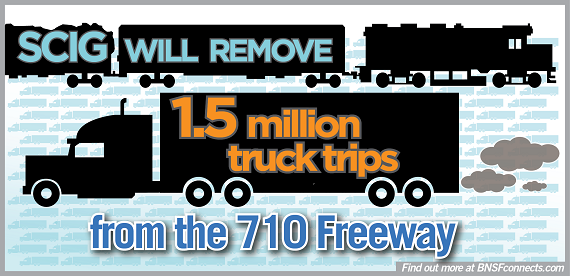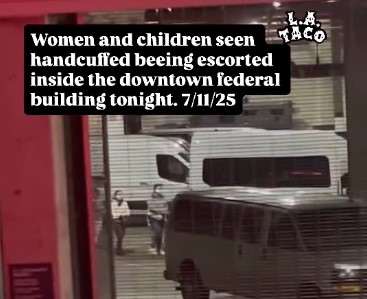
New environmental documents for a freight rail project near the Port of Los Angeles known as the Southern California International Gateway could reduce truck traffic on the Long Beach to Los Angeles portion of the 710 Freeway. But the SCIG Project faces strong opposition from the communities that will live adjacent to the 153 acre SCIG rail yard who fear the new rail yard endangers their very lives.
The Port of Los Angeles paid for an environmental study of SCIG, a freight rail depot and project that would allow containers to be loaded onto rail just four miles from the docks, rather than traveling 24 miles on local roads and the 710 freeway to rail facilities near Downtown Los Angeles. If fully utilized, the SCIG project would reduce truck trips by 1.5 million trips per year, a reduction in 300 million truck miles traveled.
While that 300 million miles per year number sounds staggering, the cost to Long Beach residents can be staggering as well. Communities in West Long Beach literally abut the gigantic rail compound without any real buffer. The local Long Beach City Councilman is pitching a plan for 100% emissions free trucks to be the only ones that can access the port, while community groups are wondering how the benefits to the air county-wide can come at the expense of the air of the residents near the project.
A letter by East Yard Communities for Environmental Justice that was circulated last April calls for the expansion of on-dock rail facilities instead of opening a new facility near a residential area.
For its part, the DEIR claims the SCIG yard would actually make air quality better. Much of the land just west of West Long Beach is already industrial and replacing the truck-based repair depots and other mixed industrial with a "green" rail transfer yard could improve the air quality in the area and reduce the cancer risk to even those people living near the SCIG transfer yard. To better understand how the Port's study claims how a rail yard will provide clean air benefits, take a moment to watch this video.
The recently released Draft Environmental Impact Report for the project concludes that "The truck trips (to SCIG) would replace truck trips that would otherwise go to the Hobart Yard in East Los Angeles, a journey of 24 miles each way. The contracts would specify that all trucks would be powered by engines that meet or exceed the 2007 EPA on-road standards, thereby ensuring compliance with the ports' 2010 Clean Air Action Plan's engine emissions requirements."
Trade unions, construction unions, and the shipping industry is backing the SCIG.
An article in the Long Beach Press-Telegram announcing the DEIR's availability notes that Diesel particulates near rail yards are traditionally dangerously high.
The draft EIR comes in the wake of a new report by UCLA's Center for Occupation and Environmental Health looking at toxic soot emitted from the existing ICTF railyard and sites in San Bernardino County.
Researchers said diesel particulate matter averages more than 1,000 parts per million in and around the yard, far above the generally acceptable limit of 25 parts per million.
For its part, BNSF, the company that would run the rail yard and lines, claims that by using newer engines for its trains and new technologies for its rail yard that particulates would be well below the numbers in San Bernadino. The total cost of constructing the project is $500 million. 20% of that, or $100 million, is specifically for investments in "green technology" products for the facility.
While the Draft environmental documents have been released, the public hearing on the documents has yet to be scheduled. If you'd like to read the documents or comment on the plan, you can find everything you need right here.






